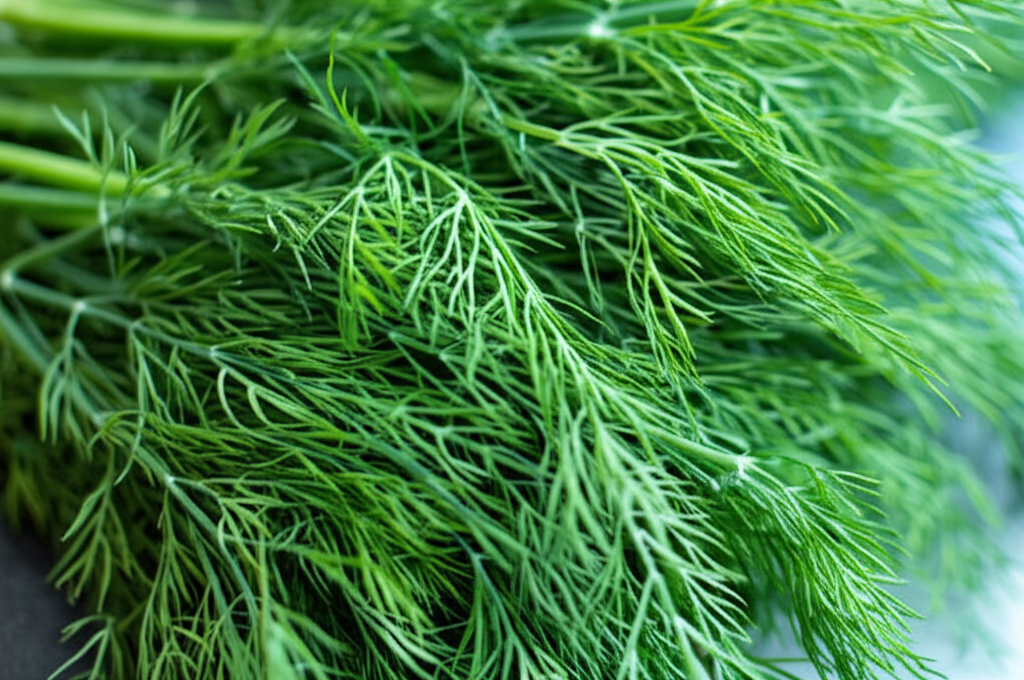Dill
Dill (Anethum graveolens) is a versatile herb with feathery green leaves and a distinctive flavor. It has been used for culinary and medicinal purposes for centuries, adding a fresh, tangy taste to many dishes while providing numerous health benefits.
Quick Facts
- ✓Family: Apiaceae (same as carrots, celery, and parsley)
- ✓Origin: Mediterranean and Western Asia
- ✓Season: Spring through Fall (peak in Summer)
- ✓Taste: Fresh, tangy, slightly sweet with hints of anise

Nutritional Value
Vitamins
- ✓Vitamin A
Supports vision and immune function
- ✓Vitamin C
Antioxidant that supports immune health
- ✓Folate
Important for cell division and DNA synthesis
- ✓Vitamin B6
Supports brain development and function
Minerals
- ✓Calcium
Essential for bone health and muscle function
- ✓Iron
Helps transport oxygen throughout the body
- ✓Magnesium
Supports muscle and nerve function
- ✓Manganese
Important for metabolism and bone development
Other Nutrients
- ✓Antioxidants
Help protect cells from damage
- ✓Flavonoids
Plant compounds with anti-inflammatory properties
- ✓Essential Oils
Provide aroma and potential health benefits
- ✓Dietary Fiber
Supports digestive health
Health Benefits
Digestive Health
Dill has been traditionally used to soothe digestive issues, including gas and bloating. It can help stimulate digestive juices and ease stomach discomfort.
Antimicrobial Properties
Dill contains compounds that may help fight certain bacteria and fungi, potentially helping to prevent infections and support the immune system.
Bone Health
The calcium content in dill contributes to maintaining strong bones and may help prevent osteoporosis when consumed as part of a balanced diet.
Stress Reduction
Compounds in dill may have calming effects on the body, potentially helping to reduce stress and anxiety when consumed regularly.
Anti-inflammatory
The flavonoids in dill have anti-inflammatory properties that may help reduce inflammation in the body and alleviate symptoms of inflammatory conditions.
Respiratory Health
Dill has been used traditionally to help clear congestion and support respiratory health, particularly during seasonal changes or minor respiratory infections.
How to Use Dill
Culinary Uses
- ✓Add fresh dill to salads for a burst of flavor
- ✓Use in fish dishes, especially salmon and trout
- ✓Mix into yogurt-based sauces and dips
- ✓Add to potato dishes for a refreshing taste
- ✓Use in pickling recipes, especially for cucumbers
- ✓Incorporate into egg dishes like omelets and frittatas
Preparation Tips
- ✓Add dill at the end of cooking to preserve its flavor
- ✓Use both the feathery leaves and stems for maximum flavor
- ✓Dried dill is more concentrated than fresh (1 tsp dried = 1 tbsp fresh)
- ✓Store fresh dill wrapped in damp paper towel in the refrigerator
- ✓Freeze chopped dill in ice cube trays with water or oil for later use
- ✓For best flavor, purchase dill with fresh, vibrant green fronds
Delicious Dill Recipes
Cucumber Dill Salad
Ingredients:
- •2 cucumbers, thinly sliced
- •1/4 cup fresh dill, chopped
- •1/3 cup plain Greek yogurt
- •1 tablespoon lemon juice
- •1 clove garlic, minced
- •Salt and pepper to taste
Instructions:
- 1In a large bowl, combine sliced cucumbers and chopped dill.
- 2In a small bowl, mix yogurt, lemon juice, garlic, salt, and pepper.
- 3Pour the dressing over the cucumbers and dill, and toss to coat evenly.
- 4Refrigerate for at least 30 minutes before serving for best flavor.
Dill Salmon
Ingredients:
- •4 salmon fillets (about 6 oz each)
- •3 tablespoons fresh dill, chopped
- •2 tablespoons olive oil
- •1 lemon, thinly sliced
- •2 cloves garlic, minced
- •Salt and pepper to taste
Instructions:
- 1Preheat oven to 375°F (190°C).
- 2Place salmon fillets on a baking sheet lined with parchment paper.
- 3Brush salmon with olive oil and sprinkle with garlic, salt, and pepper.
- 4Top each fillet with fresh dill and lemon slices.
- 5Bake for 15-18 minutes until salmon flakes easily with a fork.
Did You Know?
The name "dill" comes from the Old Norse word "dilla," which means to lull or soothe, reflecting its traditional use as a remedy for digestive issues and insomnia.
In ancient Egypt, dill was used as a soothing medicine and was also considered a sign of wealth. It was often used in Egyptian cooking over 5,000 years ago.
Dill is a member of the Apiaceae family, which also includes carrots, celery, and parsley, all known for their aromatic properties and distinctive flavors.
In medieval Europe, dill was believed to protect against witchcraft and was often used in charms and spells for protection and good fortune.
Growing Your Own Dill
Planting Tips
- ✓Plant dill seeds directly in the garden after the last frost
- ✓Choose a sunny location with well-draining soil
- ✓Space seeds about 12 inches apart and cover with 1/4 inch of soil
- ✓Dill can also be grown in containers at least 12 inches deep
Care Instructions
- ✓Water regularly but avoid overwatering
- ✓Harvest leaves once plants reach 8 inches in height
- ✓Allow some plants to flower for seed collection
- ✓Dill is a self-seeding annual that can return year after year